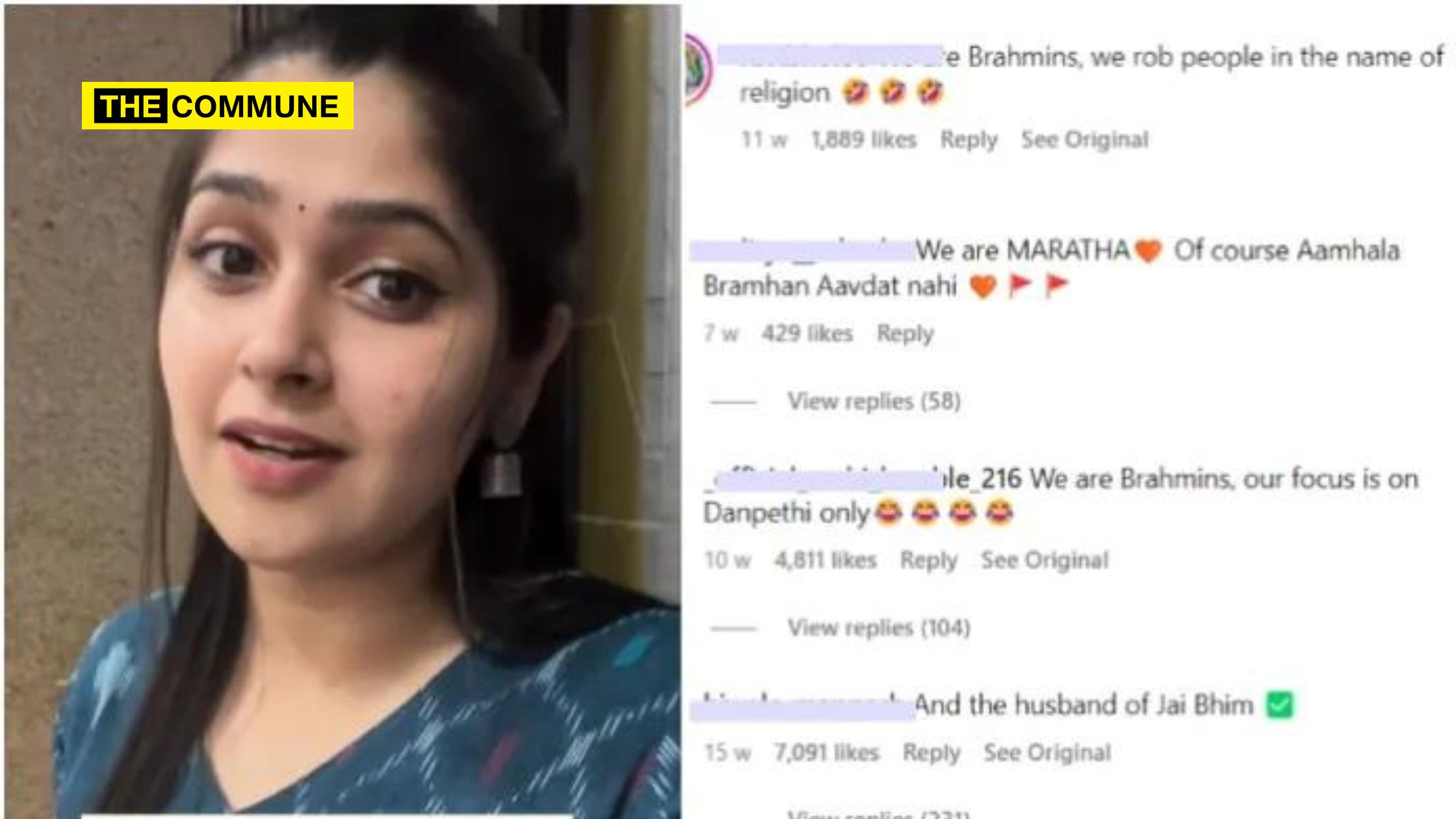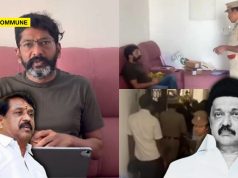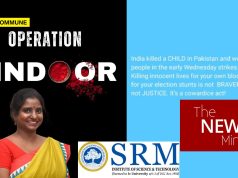
A Marathi influencer named Mansi Kulkarni faced casteist backlash online after sharing a light-hearted video on Instagram that celebrated Brahmin customs and traditions. This incident is just one of many anti-Brahmin hostilities emerging on social media in Maharashtra.
Hatred towards Brahmins in Maharashtra has deep historical and sociopolitical origins, shaped by a range of events and movements. Factors such as the caste hierarchy, the rise of the Dalit movement, and reservation policies have intensified this animosity.
Why The Anti-Brahmin Sentiment in Maharashtra?
In Maharashtra’s political landscape, there has often been a conflict between Brahminical influences and the more dominant Maratha and OBC communities. Political parties and leaders have sometimes exploited anti-Brahmin sentiments to strengthen their support among non-Brahmin groups.
Although overt hate seems to be reducing as people live together more harmoniously, new forms of casteist hostility are emerging through social media. Members of non-Brahmin communities are increasingly using these platforms to target Brahmins, questioning their actions or attempting to restore their social standing.
For example, in February this year, Marathi actress Ketaki Chitale, a Brahmin, was charged by state police for calling for a fair review of all SC/ST Act cases from the past five years. She alleged that misuse of the SC/ST Act had become a racket and demanded an investigation into these cases. Additionally, she was arrested in May 2022 for a Facebook post that contained a verse criticizing Sharad Pawar, accusing him of harbouring anti-Brahmin sentiments.
Similarly, a Marathi influencer named Mansi Kulkarni faced backlash after sharing a light-hearted video on Instagram that celebrated Brahmin customs and traditions. In the video, Kulkarni discussed various aspects of Brahmin life, including diets, the Marathi alphabet, and wedding rituals. Despite her intent to celebrate her community, the video attracted derogatory comments and casteist abuse from members of non-Brahmin communities, mainly targeting the women of the Brahmin community.
View this post on Instagram
The video has gone viral on social media, with users expressing astonishment over the backlash Mansi Kulkarni is receiving. Many are surprised by the abuse and targeting she faces simply for participating in a social media trend that involves discussing one’s community.
A netizen stated, “The amount of hate this Marathi Brahmin girl is getting is beyond sickening. She just made a simple video about her culture. What’s wrong with it? Third-class people are showing their third-grade mentality in comments.”
https://twitter.com/patilmb91/status/1816688414684774874
Another netizen wrote, “I am just shocked at the amount of abuse this innocent is being subjected to. Brahmins are less than 2%, so why is this hate against them? Is it hate against Hinduism because Brahmins are the upholders of Hindu religion and traditions.”
I am just shocked at the amount of abuse this innocent is being subjected to. Brahmins are less then 2% why this hate against them. Is it hate against Hinduism because Brahmins are the upholders of Hindu religion and traditions.
— Neena S 🇮🇳 (@neena_sen) July 25, 2024
The video, initially shared by Mansi Kulkarni, was posted on Instagram on 10th April 2024. In her caption, she clarified that she did not intend to offend any religious community. She explained that the video aimed to highlight the everyday practices and habits of Brahmins. “This reel is intended solely to showcase typical Brahmin behaviours and customs. I have no intention of hurting anyone’s religious feelings, creating discrimination, or causing offence. My focus was primarily on our food habits and some of our rituals,” she stated.

The video has amassed over 6 million views and received 8900+ comments, many of which are casteist and hatred-filled. One user states, “Brahmins are thieves, deceivers, and swindlers.” Another comment accuses Brahmins of being discriminatory. Another person remarks, “We belong to the Mahar community, and we marry Brahmin girls.”

Athawle says "I put my thing in your (Brahmin) girls, What about that? " pic.twitter.com/6b4HptkmbJ
— Based Monk (#Unreserved) (@thatindicmonk) July 25, 2024
For the past 200 years, Maharashtra has been a prominent region in India’s social renaissance, championing significant reforms. Figures such as Jyotirao Phule, Chhatrapati Shahu Maharaj, and Dr B.R. Ambedkar worked hard to combat caste and gender discrimination.
Brahmins were traditionally responsible for preserving Dharmik knowledge. Despite their role in supporting progressive movements, they faced unwarranted public hostility.
Anti-Brahmin riots of 1948
The casteist animosity towards Brahmins has historical roots. In 1948, following the assassination of MK Gandhi by Nathuram Godse—a Chitpavan Brahmin—a state-wide pogrom killed many Chitpavan Brahmins. Many accounts suggest that Congress leaders participated in this violence to consolidate their political positions.
Subsequently, Maharashtra’s political narrative has often emphasized a vision of a ‘progressive Maharashtra’ driven by the principles of Shahu, Phule, and Ambedkar, leaving little room for Brahmin leaders. During the 1960s, threats led many Brahmin families to migrate to urban areas, diminishing their presence in Marathi social discourse.
This shift led to the marginalization of Brahmin reformers and thinkers. People have forgotten Lok Hitwadi Gopal Hari Deshmukh’s contributions. Similarly, Gopal Ganesh Agarkar, known for his influential writing on social reform, is often overlooked. Even Lokmanya Tilak, once a symbol of resistance against British rule and a leader across caste lines, risks being remembered merely as a Brahmin figure. Veer Savarkar, too, has faced defamation in Maharashtra’s political landscape.
Leftist Influences Worsen the Hatred
Contemporary left-leaning and secular narratives sometimes intentionally portray these Marathi heroes as limited by their Brahmin identity, aiming to portray Hinduism as the root of social issues, with Brahmins depicted as its representatives. This view often neglects the contributions of other communities and portrays intra-Hindu conflicts as internal battles.
Today, Maharashtrian Brahmins, as a minority group, hold minimal political influence in a state where Marathas and Kunbis dominate. They continue to face discrimination in various spheres, including politics, education, and social standards. A comprehensive approach involving education, open debate, legislative reform, and active community engagement is essential to address and eliminate this prejudice. Despite the state’s caste-based benefits and reservations aimed at uplifting lower-income populations, Brahmins often face disregard and hostility due to their caste identity, which is inseparable from Hinduism.
(With Inputs From OpIndia)
Subscribe to our Telegram, WhatsApp, and Instagram channels and get the best stories of the day.




